Haedal Protocol Analysis: The No. 1 player in Sui’s liquidity staking track, with TVL crushing competitors
Author: nicoleliu.eth
Compiled by: Tim, PANews
PANews Editor's Note: Sui Ecosystem Liquidity Staking Protocol Haedal will conduct TGE on April 29, and users can receive airdrops. The author of this article is a founding partner of Comma3 Ventures, which has participated in the seed round investment of Haedal Protocol. Haedal Protocol is a hidden gem project in the field of liquidity staking in the Sui ecosystem. As the Sui staking market is ready to take off, Haedal's innovative products and strong data make it one of the preferred investment targets for DeFi.
Here’s why it’s worth investing and what you need to pay attention to 👇 (all data as of April 15)
The liquid staking market of the Sui network is not yet prosperous, with the total value of staked SUI being $307.48 million, of which only 2% is liquid. In comparison: 10.1% of the total value of staked SOL in the Solana network is liquid, while 30.5% of the total value of staked ETH in the Ethereum network is liquid, out of a total value of $10.25 billion. As the Sui ecosystem develops, the Haedal staking protocol, which currently has a TVL of $120 million, is expected to become the leader in liquid staking in the ecosystem.
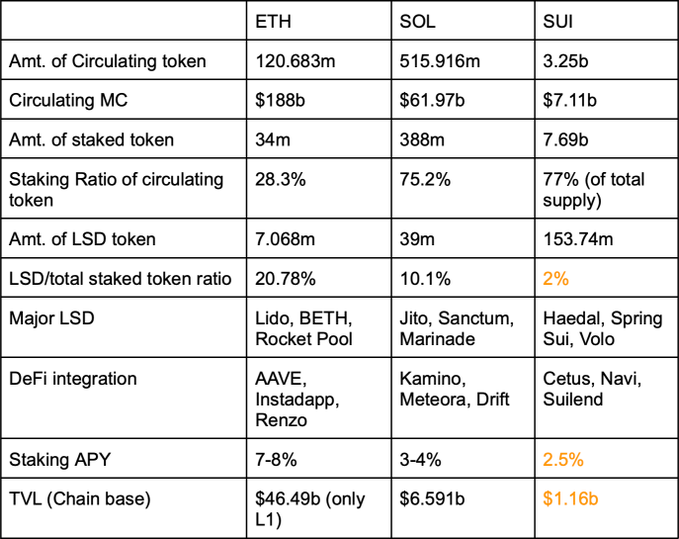
A major problem with Sui’s liquid staking derivatives market is that its staking annualized yield is low, around 2.5%, compared to Solana’s 7-8% APY and Ethereum’s 3-4%.
Haedal significantly improves the staking performance of the Sui network by adopting a dynamic validator selection mechanism and an innovative Hae3 framework: including three major components: HMM, HaeVault and HaeDAO, and its performance surpasses other LSD protocols.
Haedal monitors the status of all network verification nodes and selects the node with the highest APR when staking. When canceling the pledge, Haedal will give priority to withdrawing funds from the verification nodes with lower APR. This strategy can continuously ensure that the liquidity staked tokens maintain a high annualized rate of return.
HMM (Haedal Market Maker) optimizes the liquidity of various DEXs on the Sui blockchain by combining oracle pricing and real-time market data, and charges a transaction fee of 0.04%.
From February to March, trading volume increased from $59.13 million to $284.15 million, generating $236,000 in fees, with an average TVL of $800,000 during the period. After using 50% of the revenue for incentives, haSUI's annualized rate of return increased by 24.4%, from 2.58% to 3.21%.
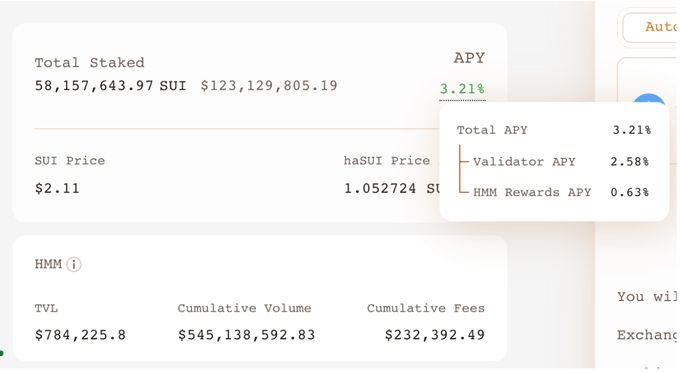
Cetus Protocol is the largest DEX in the Sui ecosystem, with a daily trading volume of $92 million. Haedal was launched on January 6, 2025, and currently has a daily trading volume of $5.69 million, equivalent to 6.12% of Cetus's trading volume. By adopting an oracle pricing mechanism, HMM is poised to achieve rapid revenue growth by capturing arbitrage trading volume.
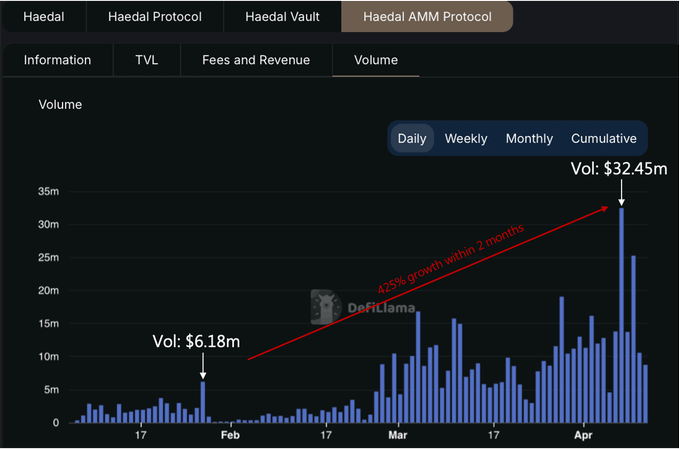 Haedal Vault simplifies the liquidity provision process for users with idle funds, eliminating the tedious operations of managing LP positions, allowing users to easily deposit funds and obtain higher returns.
Haedal Vault simplifies the liquidity provision process for users with idle funds, eliminating the tedious operations of managing LP positions, allowing users to easily deposit funds and obtain higher returns.
HaeVault improves returns through ultra-narrow rebalancing strategies. Taking the SUI-USDC trading pair as an example, the annualized rate of return provided by the Cetus platform is 250.8% (based on Cetus data), while HaeVault achieves an annualized rate of return of 1117%. After deducting 16% of the fee, the net rate of return is still as high as 938%.
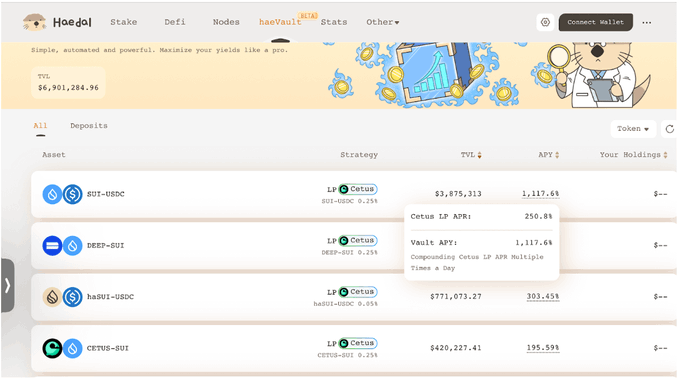
Hae3 is deeply integrated into the Sui DeFi ecosystem (TVL exceeds $1 billion). Among them, the HMM protocol captures DEX fee income, the Haedal vault optimizes the income of liquidity providers, and HaeDAO grants governance decision-making power.
Volo and Suilend, which focus on basic staking and lending operations, lack this synergy, making Haedal a superior yield optimizer.
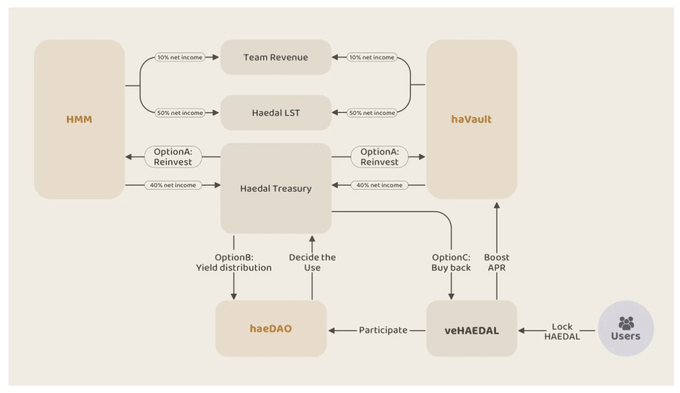
The use cases of HAEDAL tokens further solidify their value. Locking them into veTokens can be used to participate in HaeDAO governance or to increase the annualized rate of return of the treasury. In addition, potential airdrop opportunities (which are very common in the Sui ecosystem) also add additional advantages.
Haedal's core indicators are strong: TVL reached $117.36 million (compared to Suilend's $117.4 million and Volo's $50 million), the number of daily active wallets exceeded 44,000, and the number of holders reached 794,000. Currently, Haedal is temporarily in the leading position in the three key indicators of transaction volume, annualized rate of return and holder size.
Support from VC institutions such as Hashed, Comma3, OKX Ventures and Animoca Brands further illustrates its potential.
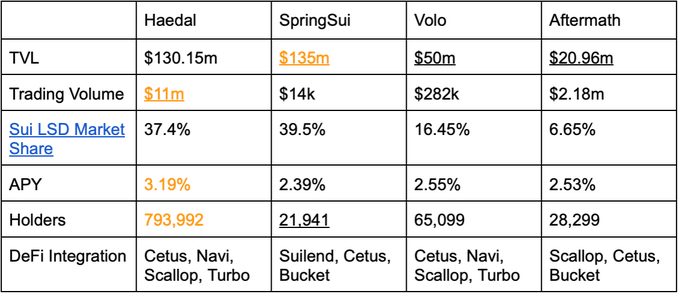
Haedal stands out with its high-growth market (LSD penetration is only 2%, with a 10-fold growth potential), innovative products and solid fundamentals. As the Sui ecosystem expands, the protocol is in a favorable position in the field of liquidity staking and is expected to become an industry leader.
You May Also Like

Here’s Why Mantle (MNT) Price Is Pumping Today

Bitcoin Exchange Balance Drops To Six-Year Low Amid Shortage
